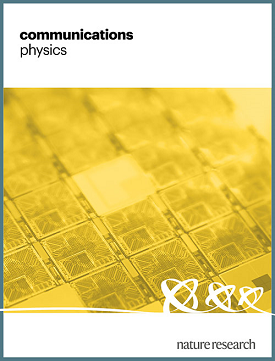Chiral active systems near a substrate: Emergent damping length controlled by fluid friction
IF 5.4
1区 物理与天体物理
Q1 PHYSICS, MULTIDISCIPLINARY
引用次数: 0
Abstract
Chiral active fluids show the emergence of a turbulent behaviour characterised by multiple dynamic vortices whose maximum size varies for each experimental system, depending on conditions not yet identified. We propose and develop an approach to model the effect of friction close to a surface in a particle based hydrodynamic simulation method in two dimensions, in which the friction coefficient can be related to the system parameters and to the emergence of a damping length. This length is system dependent, limits the size of the emergent vortices, and influences other relevant system properties such as the actuated velocity, rotational diffusion, or the cutoff of the energy spectra. Comparison of simulation and experimental results of a large ensemble of rotating colloids sedimented on a surface shows a good agreement, which demonstrates the predictive capabilities of the approach, which can be applied to a wider class of quasi-two-dimensional systems with friction. The dynamics of chiral active fluids is characterised by a multitude of interacting dynamic vortices whose maximum size varies for each system. Here we show how the friction induced by the substrate is related to a damping length which is ultimately responsible of limiting the maximum size of the vortices.

基底附近的手性活性系统:由流体摩擦控制的新兴阻尼长度
手性活性流体会出现以多个动态涡流为特征的湍流行为,这些涡流的最大尺寸因每个实验系统而异,取决于尚未确定的条件。我们提出并开发了一种方法,在基于粒子的二维流体力学模拟方法中模拟靠近表面的摩擦效应,其中摩擦系数可与系统参数和阻尼长度的出现相关联。该长度与系统有关,限制了出现的漩涡的大小,并影响其他相关的系统特性,如驱动速度、旋转扩散或能量谱的截止。对沉积在表面上的大量旋转胶体的模拟和实验结果进行比较后发现,两者的结果非常吻合,这证明了该方法的预测能力,它可以应用于更广泛的具有摩擦力的准二维系统。手性活性流体的动力学特征是存在大量相互作用的动态漩涡,每个系统的最大尺寸各不相同。在这里,我们展示了基底引起的摩擦力与阻尼长度的关系,而阻尼长度最终限制了旋涡的最大尺寸。
本文章由计算机程序翻译,如有差异,请以英文原文为准。
求助全文
约1分钟内获得全文
求助全文
来源期刊

Communications Physics
Physics and Astronomy-General Physics and Astronomy
CiteScore
8.40
自引率
3.60%
发文量
276
审稿时长
13 weeks
期刊介绍:
Communications Physics is an open access journal from Nature Research publishing high-quality research, reviews and commentary in all areas of the physical sciences. Research papers published by the journal represent significant advances bringing new insight to a specialized area of research in physics. We also aim to provide a community forum for issues of importance to all physicists, regardless of sub-discipline.
The scope of the journal covers all areas of experimental, applied, fundamental, and interdisciplinary physical sciences. Primary research published in Communications Physics includes novel experimental results, new techniques or computational methods that may influence the work of others in the sub-discipline. We also consider submissions from adjacent research fields where the central advance of the study is of interest to physicists, for example material sciences, physical chemistry and technologies.
 求助内容:
求助内容: 应助结果提醒方式:
应助结果提醒方式:


